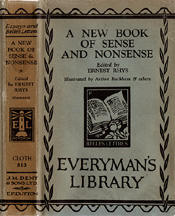
The typical Everyman's Library book bound and jacketed during the "Shield Era" from 1928 to 1934 is characterized by a colored paper dust jacket over a book with a shield-like gilt spine design. Binding colors, jacket icons, and interior details vary among the thirteen sections of the library: Biography, Classical, Essays and Belles Lettres, Fiction, History, Oratory, Poetry & Drama, Reference, Romance, Science, Theology & Philosophy, Travel & Topography, and Young People.
New collectors of Everyman's Library are often confused by books that have mismatched
dates, bindings, and jackets. Such mismatches are common and are due to the way Dent manufactured
Everyman's titles. Books were printed in batches of about 10,000 and stored, unbound, until orders
were received. Jackets were also printed and stored. Because of this, slower-selling titles often
have mismatched dates, bindings, and jackets: a slow selling title printed in the Flatback Era could
be bound late in the Shield Era, but not jacketed until the Ravilious Era.
In order to give a basic overview of the series in the Shield Era, two typical Everyman's titles from this era are illustrated first in detail below, followed by examples from each of the thirteen sections. Unless otherwise noted, all images on this page are from the collection of John B. Krygier.
Click thumbnails to enlarge images

Dust Jackets
In 1928 Everyman's dust jackets were redesigned and printed on colored paper, a significant change from earlier jackets. From 1928-1932 the jackets resemble Ainsworth's Rookwood, No. 870 (1931) (left, top). The jacket spine includes a lighthouse, indication of binding style (in this case, cloth), and series number. The jacket front includes border graphics and a new cover icon designed by Reginald L. Knowles for each of the thirteen sections.
In 1932 this jacket design was modified, and resembles Edgeworth's Castle Rackrent & The Absentee, No. 410 (1934). The lighthouse and binding style were removed from the jacket spine, and on the jacket front the border graphics were simplified and the series number added. Dent and Dutton were indicated on all jackets throughout this era. Advertisements on the jackets were restricted to The Everyman's Encyclopedia and titles in the series.

Bindings
In the Shield Era, Everyman's books continued to be bound in a glossy cloth material, but with a redesigned spine, technically a "cartouche" but often referred to as a shield. The embossed Dent floral icon was retained on the cover. Early in this era, the bindings are flatbacked, but later were replaced with a more common curved binding. The color of the binding continued to indicate which of the thirteen categories the title is from, examples of which are shown below.

Endpapers
Reginald L. Knowles designed the endpapers used on Everyman's Library books until 1935. The pale yellow endpapers illustrate the figure of Good Deeds from the medieval play Everyman, facing her sister Knowledge's pledge, which is the series motto: "Everyman, I will go with thee and be thy guide, in thy most need to go by thy side."

Half-title Page
Preceding a blank page (or flyleaf), each Everman's book has a half-title page that indicates which section of Everyman's Library the book belongs to, as well as the title and author of the book.

Advertisement Page
The reverse side (verso) of the half-title page contains the series number of the book, and an advertisement for the series.

Title Pages
An ornate frontispiece and title-page reflects the style of William Morris and is one of the most distinctive elements of early Everyman's titles. Thirteen different corresponding designs and quotes were created for the thirteen sections in the series. Ainsworth's Rookwood is in the Fiction section.

Copyright Page
The copyright page is on the verso of the title page. No date indicates a first printing. A single date also indicates a first printing, as on Ainsworth's Rookwood. As with the previous era of Everyman books, printings subsequent to the first are indicated. Titles with numerous reprints sometimes omit all but the date of first and last printing.





















































